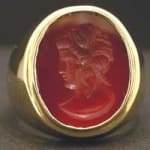Roman Carnelian Intaglio of the Bust of a Deity, 100 CE - 300 CE
Carnelian-Gold
FJ.6776
This Genuine Ancient Seal Has Been Set in a Modern 18 Karat Gold Rin The art of glyptics, or carving images on colored precious stones, is probably one of the...
This Genuine Ancient Seal Has Been Set in a Modern 18 Karat Gold Rin
The art of glyptics, or carving images on colored precious stones, is probably one of the oldest known to humanity. Intaglios, gems with an incised design, were made as early as the fourth and third millennia B.C. in Mesopotamia and the Aegean Islands. They exhibit a virtuosity of execution that suggests an old and stable tradition rooted in the earliest centuries. The tools required for carving gems were simple: a wheel with a belt-drive and a set of drills. Abrasives were necessary since the minerals used were too hard for a metal edge. A special difficulty of engraving intaglios, aside from their miniature size, was that the master had to work with a mirror-image in mind.
The bust of a youthful deity has been engraved onto the polished face of this precious gemstone. Might this be a representation of the God Apollo. God of music and prophecy, patron of the arts and artists, surely this individual would be a fitting figure to grace this ring. Although the identity of this individual is pure conjecture, one can definitively appreciate the extraordinary beauty of the intaglio. The level of portraiture and pathos achieve by the carver is remarkable given the density of the material and the intimate confines of the surface. The smoothness and detail of the carving both convey that this seal was engraved by a master. Although the beauty of youth as embodies by this god is fleeting, the beauty of this seal and the ring is eternal. Throughout time, certain styles emerge that transcend particular tastes and outlast temporary trends. We deem these elusive styles “classics.” This ring, a combination of an ancient seal and an elegantly refined setting, is just one such classic.
The art of glyptics, or carving images on colored precious stones, is probably one of the oldest known to humanity. Intaglios, gems with an incised design, were made as early as the fourth and third millennia B.C. in Mesopotamia and the Aegean Islands. They exhibit a virtuosity of execution that suggests an old and stable tradition rooted in the earliest centuries. The tools required for carving gems were simple: a wheel with a belt-drive and a set of drills. Abrasives were necessary since the minerals used were too hard for a metal edge. A special difficulty of engraving intaglios, aside from their miniature size, was that the master had to work with a mirror-image in mind.
The bust of a youthful deity has been engraved onto the polished face of this precious gemstone. Might this be a representation of the God Apollo. God of music and prophecy, patron of the arts and artists, surely this individual would be a fitting figure to grace this ring. Although the identity of this individual is pure conjecture, one can definitively appreciate the extraordinary beauty of the intaglio. The level of portraiture and pathos achieve by the carver is remarkable given the density of the material and the intimate confines of the surface. The smoothness and detail of the carving both convey that this seal was engraved by a master. Although the beauty of youth as embodies by this god is fleeting, the beauty of this seal and the ring is eternal. Throughout time, certain styles emerge that transcend particular tastes and outlast temporary trends. We deem these elusive styles “classics.” This ring, a combination of an ancient seal and an elegantly refined setting, is just one such classic.



